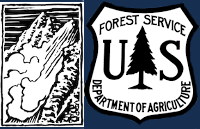Snowpack and Avalanche Discussion
<p><span><span><span>While there is an inch or two of new snow, the mountains around West Yellowstone and Island Park, including the Southern Gallatin and Southern Madison Ranges received up to 0.4” of rain before temperatures dropped below freezing. Consider the adage, “Weird weather makes weird avalanches” expanding terrain choices if you do not encounter any signs of instability. </span></span></span></p>
<p><span><span><span>Rain at low and mid-elevations may have destabilized snow by adding water to the snowpack. <strong>Wet loose avalanches </strong>starting in a small area and entraining heavy snow as they slide are possible, and you may encounter areas where the snowpack is saturated and unsupportable, especially on thinner, low elevation slopes. Higher elevations and northern aspects will not have these same instabilities and will hold better snow but evaluate the hazard on routes to and from target recreation areas. </span></span></span></p>
<p><span><span><span>At upper elevations, it is likely that more snow fell and there was less rain. Triggering a small avalanche within wind-drifted snow is possible where new snow is deeper, temperatures were cool enough to build surface crusts and on north-aspects that have not undergone melt-freeze cycles. <strong>Wind slab avalanches </strong>breaking on steep slopes with fresh drifts will be less than 6 inches deep. Watch for shooting cracks and consider the consequences of a small avalanche given the characteristics of the terrain. </span></span></span></p>
<p><span><span><span>The danger is MODERATE due to higher levels of uncertainty about how the snowpack will tolerate today’s mix of rain and snow. </span></span></span></p>
<p>There is a trace to one inch of new snow in the mountains around Bozeman, Big Sky and Cooke City. The snowpack is mostly stable with generally safe avalanche conditions. Evaluate the snowpack for isolated instability in recent wind drifts and wet snow if travel plans include steep and extreme terrain.</p>
<p>The snowpack surface on shadier, upper elevation slopes has not experienced the same cycle of freezing and thawing that most other areas have. Most wind drifts have stabilized since this weekend, but small, human-triggered <strong>wind slab avalanches </strong>can have outsized consequences in dangerous terrain. A small wind slab avalanche in Cooke City yesterday is a good example (<a href="https://www.mtavalanche.com/node/34880"><strong>details and photo</strong></a>). The new snow will not add much to the hazard but could mask visual clues of recent drifting. Evaluate the upper snowpack for isolated instability before considering very steep terrain.</p>
<p>Cooler temperatures, clouds and wind should eliminate <strong>wet loose avalanche </strong>activity, but you may encounter isolated areas in the trees and at lower elevations where the problem lingers. Saturated snow deeper than the upper few inches of the snowpack indicates an area with potential instability.</p>
<p><span>Avalanches are unlikely, and the danger is LOW. </span></p>
Hyalite Road Closure
The Hyalite Canyon Road is closed to ALL MOTORIZED VEHICLES until May 16. This is a regular annual road closure to reduce road damage during the spring thaw. Bicycle and foot traffic are allowed. Contact the Bozeman FS Ranger District for more info.
